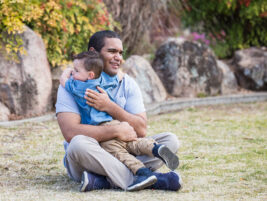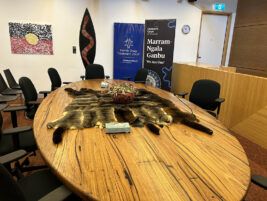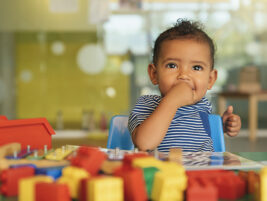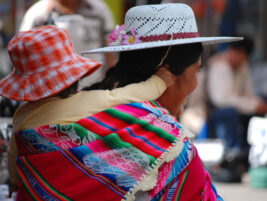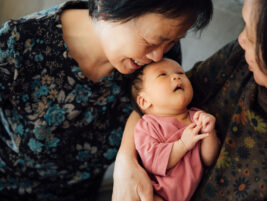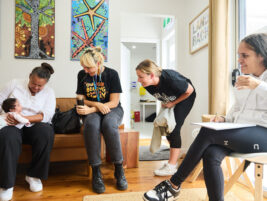Sexual abuse of infants has become increasingly manifest in South Africa. Statistics from the Red Cross War Memorial Children’s Hospital show a steady increase in presenting cases: 200 records traced from 1991 – 1999 (van As et al, 2001) to 294 cases seen from 2003 – 2005. Fifty four percent of children in this latter group were less than 5 years old (Cox et al, 2007).
The reasons for this horrific act of sexually abusing very young children and even infants are multiple and complex (Pritchard et al, 2002; Meier, 2002). Notions of patriarchy, male dominance, alcoholism, overcrowding, and cycles of abuse come into play in an extreme form. Added to this is the HIV pandemic in South Africa.
Babies and toddlers are less likely to suffer from this disease and hence are regarded as safe sexual objects. Added to this is the belief in virgin cleansing: this is an old universal myth which was even present in Scotland in the early 1900’s. It is a myth that has been much debated and spoken about in South Africa, but no robust evidence exists that it is an entrenched and acted-upon belief today (Jewkes, 2004).
In the case that will be described, the issue of male dominance and revenge is pertinent – revenge from the man towards the woman. How best to punish a woman than by hurting her baby?
This brief paper is a synopsis of a high profile case of infant rape. Justice cannot be done to the infant or her family in this brief narrative, but it is important that their story be told. I feel privileged to have been so closely involved in this case and thank the mother and foster family for their permission to talk about them and their child.
Baby Tshepang
The story of an infant who became known as “Baby Tshepang” burst into the open with horror reports on the television and newspapers in October 2001: three elderly men, one of whom was the grandfather to the 9 old month baby, were arrested following the claim that they had raped an infant. The community they come from is in a poor Northern Cape rural area, where the sheep farms are huge, the droughts severe and the deprivation of the farm workers great – they have not tasted the milk and honey of the new South Africa. Alcohol abuse is rife, education and social services exist only at the most basic level. As it turned out a few weeks later, the 3 alleged perpetrators were not the guilty ones. The real one turned out to the mother’s ex-boyfriend, who had been angry with her for having jilted him. He was apprehended and is currently serving a life long jail term. The 3 older men were released and paid compensation for the overly hasty police action.
The little girl was named “Tshepang” by the Northern Cape Member of the Executive Committee meaning ‘have hope’ in Tswana – so desperate and shocked was the whole community that something positive had to be found and, when all is dark, there is only hope.
Baby Tshepang was treated as an emergency and given anti-retroviral medication in a local hospital; but when the doctors saw the extent of her injuries they referred her to the only children’s hospital in Sub-Saharan Africa, the Red Cross War Memorial Children’s Hospital in Cape Town. There paediatric surgeons had to perform major reconstructive surgery to her genital area and she needed a colostomy for few months in order to ensure sepsis free healing of her wounds.
Child Psychiatry only became involved 3 weeks after her admission when I was asked to comment by a newspaper, and I then requested to see her. The surgeons had not thought of referring her, so preoccupied were they with her physical condition.
Immediate psychotherapeutic intervention
I met N (the abbreviation of her real name) in the corridor of the ward, in a walking ring, greeting me with a serious gaze and looking wistfully at the gate which closes the ward corridor off from the central area of the hospital floor. The nursing staff said that she was fine, to them she seemed happy. It was only the more discerning social worker of the ward who said that N was searching for her mother. I was informed that P, her young mother of 16 years, had been sent back to the Northern Cape as the local Social Workers had insisted that she go to school (though she had not been in school for the past 2 years).
The first therapeutic intervention was to insist that P be brought back to the Hospital to be with her child as a matter of urgency. This took a few days and required much persuasion and authority to ensure that the wish of the Social Agency did not prevail.
Upon her mother’s return N visibly relaxed and became happy. A string of national and international newspaper and television crews visited them, and the case assumed huge proportions. The Media Monitoring Project was commissioned to analyse the media coverage of this rape case. Of the 155 newspaper articles, 80 covered “Baby Tshepang” (Bird et al, 2004). There was even a play “Tshepang”- described as an ‘irredeemably grim piece’1- produced locally and also internationally.
A number of sessions with N and her mother followed. Time does not allow giving details of the assessment. The history is a painful one, but is probably an average one for the kind of community she comes from. Of note though is that the relationship P. had had with her little girl had been a positive one, very much supported by the maternal grandmother.
N was a delicately built toddler, with pale skin, beautifully dressed – she had been showered with gifts from all over the world! She engaged enthusiastically with the world around her. She was very confident in her mother’s presence, and explored the room and the toys freely, making regular reference to her mother.
Almost immediately it felt that this child had been given the right name: despite the horror, she represented hope and until now, this intuition has proven correct.
The recommendations to Social Services were that N and her mother not be separated, but that they both needed mothering. In view of the publicity storm that had been created around them, it was agreed that they should probably not return to their community of origin, but that they should both be placed in foster care elsewhere. A minister of the church and his wife volunteered to foster N and include her mother in this. They had a little boy of almost exactly the same age. This has been the most successful foster placement I have been privileged to witness. The transition for N was smooth and not traumatic, as she was in contact with her mother daily, but also got to know her foster family.
When P turned 18, she sadly fulfilled the pessimistic predictions of the Social Workers, and left school and the foster family and went home to her mother, back into this deprived community. By this time however N was well attached and did not miss her mother much, though she talked about her freely – the foster parents did all they could to keep regular contact with her biological mother.
I was able to follow N’s symptom progression as the family visited Cape Town at 6 monthly intervals and always agreed to come for a session.
Subsequent psychotherapeutic contact
To recapitulate: this little girl was brutally raped at the age of 9 months, resulting in third degree vaginal tears, extending into her anus, requiring major reconstructive surgery, which included a colostomy for the first 4 months post-trauma. The care she received subsequently was from a medical and emotional perspective optimal, with the one possible hiatus: that no regular psychotherapeutic intervention has been possible.
The evolution of N’s presentation over the following 3 years will be sketched in a much abbreviated format.
One year post the rape, her foster mother reported that for past 2 – 3 months N had been waking up at night and screaming and saying “eina” (which means ‘ouch’ in Afrikaans) and then holding tightly onto mother. She had also been observed to climb onto children and even mother and make thrusting movements. At times she could be quite aggressive. She was scared of noises of machines – the cleaning machine, washing machine, the steam iron – she would then go to the other end of the room.
During this particular session she immediately played with the toys, particularly the doll that she held and rocked and wanted to put to sleep and also bath. When undressed she spontaneously pointed to the genital area and mother reflected that the doll was sore, like N, who apparently often pointed to the scar of the colostomy on her abdomen. This clearly preoccupied her and she spent much time thereafter taking care of the doll.
Eight months after this visit the foster parents and mother, whom I saw for the last time on this occasion, stated that she had continued to masturbate and show an increased awareness of the genital area. The nightmares had however decreased. Very strikingly in her play N, by now 2½ years old, made red chalk marks on the dolls in their lower body parts. She seemed more distant from her mother and her face brightened when she was reunited with her foster parents and brother. Mother at this stage had returned to her family of origin and the contact between them had been less frequent.
In December 2003, when N turned 3 years, she came with her foster family only; her mother had become increasingly unreliable and also exploitative of the publicity around her child. N was by now securely attached to her foster family and they treated her in the same manner as they did their biological son.
There were no major behaviour problems though some peculiarities remain: N remained very aware of the genital area of the dolls and was interested in sexual differences – this however could have been by now age appropriate. She was masturbating less than before. Foster-parents had noted that she at times would stand in front of their bed, pressing against where her abdominal scar is. When they entered, she seemed to get a fright, and would react defensively. They speculated whether she was having any associations of her trauma while standing next to the bed. Foster-mother had also noted that she sought out men when they had visitors.
She still had the occasional nightmare, but this too had lessened since last seen.
Foster-parents keep the communication about her biological family alive and open.
She had been fully toilet trained, and foster mother was planning of sending the two children to a play-school the following year.
At age 3½ she was again seen– the nightmares had now completely resolved, there was less crying. The sexual behaviour and interest had virtually disappeared, other than a normal curiosity which her foster-brother also had. She is aware of the scar on her stomach – and would say “die dokters het my seergemaak”. (the doctors have hurt me) When N was 4 years 4 months old she presented as a lively, interactive, bright little girl who was confident and a ‘leader’. She played appropriately with her foster-brother and on family interview nothing untoward could be detected.
One year later, in April 2006, when she was 5 years 4 months, N again was bright, very observant and this time it was considered important to see her individually. She took this space with ease and it was evident that it would not take much to allow for repressed memories to emerge. She offered that she was scared of watching wrestling on TV; she was very clear on sexual differentiation and keeping boys and girls separate. She acknowledged that something scary had happened to her, but then became defensive, drew a black flower, and said it was closed. In view of the fact that a follow up session would be far into the future, the matter was not pursued further.
Discussion
N initially showed symptoms of anxiety and fear – separation anxiety (though ‘hidden’) and fear towards men. As time passed and as her cognitive, language and motor abilities developed, she displayed the entire spectrum of Traumatic Stress Disorder. What was most distressing was that she had retained a somatic memory of what had happened to her and that she acted this out – her masturbation and sexual interest. I do contend that this was out of keeping of her family environment and age at the time and that it had everything to do with her trauma. This is in line with theories regarding memory and the finding that “even in the first year of life, infants experience evocative memories that are not dependent on an external stimulus.” (Gaensbauer, 2002)
The symptoms have disappeared in time and what has remained is the repressed memory of the trauma, being manifested now in a displaced and symbolic manner.
This little girl has had no access to regular psychotherapy. She has done well up to now with the excellent care and the ordinary love she has received from her foster family. Had she lived nearer to Cape Town regular therapy would have been recommended– but given the circumstances, all we can do is observe her and keep a connection albeit at 6 monthly or yearly frequency. The publicity that continues to surround her, especially on her birthday, is something that needs attention.
The points which the case of Baby Tshepang illustrates are the following:
1. In the face trauma, supporting the attachment relationship is the first task of the health professional. Coping mechanisms can only be employed if the primary attachment relationship is secured (Shore, 2001); without this the Traumatic Stress Disorder would not have resolved spontaneously and N would not have become a Child of Hope.
2. Infants, even at the pre-verbal stage, remember trauma; it becomes enacted as a somatic memory. “The body keeps the score” (van der Kolk, 1994) was literally demonstrated in this case.
3. With the development of cognition and language this somatic memory can be made it accessible through symbolization. Psychotherapy, the conscious working through of the trauma, then becomes possible. Whether this working through can occur naturally with in-tune parents and a good environment remains to be seen. The challenge with this case is of course that the story about what had happened cannot so easily be told as in the case described by Gaensbauer (2000), where an illness during infancy necessitated medical procedures.
In conclusion
N does indeed do honour to her pseudonym as she is a ‘child of hope’. Her easy temperament and robust physical constitution, as well as the secure beginning with her young mother, who despite the environmental deprivation has loved her, have been protective factors that made it possible for her to survive this catastrophic trauma to her body.
The subsequent respect shown for her needs for solid and ongoing attachments with her ordinarily loving foster family have enabled her to develop sound ego functions. There is hope that these will equip her to deal with the complexity of growing up and knowing her story and to incorporate this into her developing identity as a woman.
From a mental health perspective her suffering as well as her healing was caused by, and came directly from her human environment – the role of the professional was to help actualize and to support the good that was available in her community.
References
Bird, W., Spurr, N. (2004). Media representations of baby rape: the case of ‘Baby Tshepang’. In L. Richter, A. Dawes, C. Higson-Smith (eds). Sexual abuse of young children in southern Africa (pp 36-52). Cape Town, HSRC Press.
Cox, S. Andrade, G., Lungelow, D., Schloetelburg, W., Rode, H. (2007). The child rape epidemic. South African Medical Journal. 97 (10), 950–955.
Gaensbauer, T.J. (2000). Psychotherapeutic treatment of traumatized infants and toddlers: A case report. Clinical Child Psychology and Psychiatry. 5(3), 373-385.
Gaensbauer, T.J. (2002). Represenations of Trauma in Infancy: Clinical and Theoretical Implications for Understanding of Early Memory. Infant Mental Health Journal. 23, 259-277.
Jewkes, R. (2004). Child sexual abuse and HIV infection. L. Richter, A. Dawes, C. Higson-Smith (eds). Sexual abuse of young Children in southern Africa (pp 130-142). Cape Town, HSRC Press.
Meier, E. (2002). Child rape in South Africa. Pediatric Nursing. 28 (5), 632-635.
Pitcher, G.J., Bowley D.M.G. (2002). Infant rape in South Africa – Commentary. Lancet. 359 (Jan 26), 274-275.
Shore, A. (2001). The effects of a secure attachment relationship on right brain development, affect regulation, and infant mental health. Infant Mental Health Journal, 22, 57-66.
Van As, A.B., Withers, M., du Toit, N., Millar, A.J.W., Rode, H. (2001). Child rape – Patterns of injury, management and Outcome. South African Medical Journal, 91 (12), 1035-1038.
Van der Kolk, B.A. (1994). The body keeps the score: memory and the evolving psychobiology of posttraumatic stress. Harvard Review of Psychiatry. 1, 253-265.
Child of Hope: Sexual trauma in Infancy
Authors
Berg, Astrid,
UCT Parent-Infant Mental Health Service
Red Cross War Memorial Children’s Hospital and University of Cape Town
South Africa



